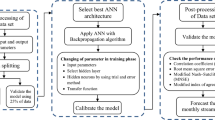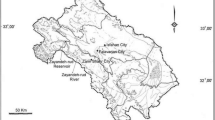Abstract
Streamflow estimation plays an important role in water resources planning and management, and minimizes the impact of floods and droughts. Therefore, this study aims to estimate monthly streamflows in a semi-arid region of India by employing multiple data-driven models, which include standalone time-series models such as Thomas-Fiering (T-F), autoregressive moving average (ARMA), and the logistic smooth threshold autoregressive (LSTAR) models, artificial intelligence (AI) technique such as artificial neural network (ANN), and an advanced novel hybrid model such as LSTAR coupled with generalized autoregressive conditional heteroscedasticity (GARCH), i.e., LSTAR-GARCH model. Furthermore, capability of five models including standalone models (T-F, ARMA), a cascade feed-forward back propagation neural network (CFBPNN), LSTAR, and the hybrid LSTAR-GARCH model, was comparatively evaluated in estimating 40-year (June 1975 to May 2015) monthly streamflow of Jakham reservoir located in Rajasthan state of India. The models were calibrated using first 75% of the dataset, and their predictions were evaluated using four performance evaluation criteria: correlation coefficient (R), root mean square error (RMSE), modified Nash-Sutcliffe efficiency (MNSE), and modified index of agreement (MIA). The developed models were validated using remaining 25% dataset (120 months), and their performances were compared by plotting hydrographs and scatter plots between the observed and estimated values. The results suggested that the T-F model was satisfactory for generating synthetic monthly streamflow while the ARMA model accurately estimated the streamflows except at extremes. Among the stand-alone models, CFBPNN-4 model outperformed the other three ones with a higher MNSE value of 0.53, and a lower RMSE value of 30.78 million m3. The proposed hybrid LSTAR-GARCH model, which is based on a novel framework, outperformed the standalone ones in terms of R, MNSE, MIA, and RMSE (0.89, 0.78, 0.58, and 25.92 million m3, respectively).






Similar content being viewed by others
Data Availability
All authors have contributed to the conception and design of the study. Data collection and Map preparation were performed by Priyanka Sharma and Survey D. Sharma. The analysis part was done by Priyanka Sharma and Farshad Fathian. The manuscript was written by Priyanka Sharma, Farshad Fathian and Deepesh Machiwal. Significant contribution to the editing of the manuscript was made by Deepesh Machiwal and S. R. Bhakar.
Code Availability
Not applicable.
References
Adamowski J, Chan HF, Prasher SO et al (2012) Comparison of multiple linear and nonlinear regression, autoregressive integrated moving average, artificial neural network, and wavelet artificial neural network methods for urban water demand forecasting in Montreal, Canada. Water Resour Res 48(1):W01528
Alfa MI, Ajibike MA, Adie DB (2018) Reliability assessment of Thomas Fiering’s method of stream flow prediction. Niger J Technol 37(3):818–823
Amiri E (2015) Forecasting daily river flows using nonlinear time series models. J Hydrol 527:1054–1072
Artrith N, Urban A (2016) An implementation of artificial neural-network potentials for atomistic materials simulations: performance for TiO2. Comput Mater Sci 114:135–589
Bae I, Ji U (2019) Outlier detection and smoothing process for water level data measured by ultrasonic sensor in stream flows. Water 11(5):951
Bollerslev T (1986) Generalized Autoregressive conditional heteroscedasticity. J Econom 31:307–327
Chekole AG, Belete MA, Fikadie FT et al (2024) Evaluate the performance of HEC-HMS and SWAT models in simulating the streamflow in the Gumara watershed, Ethiopia. Sustainable Water Resour Manage 10(1):26
Cryer JD, Chan KS (2008) Time Series Analysis with Applications in R. Second edition. Springer, New York
Cui Q, Wang X, Li C et al (2016) Improved Thomas-Fiering and wavelet neural network models for cumulative errors reduction in reservoir inflow forecast. J Hydro-Environ Res 13:134–143
Dashora I, Singal SK, Srivastav DK (2015) Software application for data driven prediction models for intermittent streamflow for Narmada River Basin. Int J Comput Appl 113(10):9–17
Dey P, Roy S, Bathi JR et al (2023) Evaluation of uncertainty in stream flow prediction using Monte Carlo simulation for watershed-scale hydrological modeling. J Hydrol Eng ASCE 29(1):05023026
Elganiny MA, Eldwer AE (2016) Comparison of stochastic models in forecasting monthly streamflow in rivers: a case study of River Nile and its tributaries. J Water Resour Prot 8(2):143–153
Fang JJ, Yang L, Wen X et al (2024) A deep learning-based hybrid approach for multi-time-ahead streamflow prediction in an arid region of Northwest China. Hydrol Res 55(2):188
Fashae OA, Olusola AO, Ndubuisi I et al (2018) Comparing ANN and ARIMA model in predicting the discharge of River Opeki from 2010 to 2020. River Res Appl 35(2):169–177
Fathian F, Mehdizadeh S, Kozekalani Sales A et al (2019) Hybrid models to improve the monthly river flow prediction: integrating artificial intelligence and non-linear time series models. J Hydrol 575:1200–1213
Fernandez GP, Chescheir GM, Skaggs RW et al (2005) Development and testing of watershed-scale models for poorly drained soils. Trans ASAE 48(2):639–652
Franses PH, Van Dijk D (2000) Non-linear Time Series models in empirical finance. Cambridge University Press, Cambridge
Gautam VK, Pande CB, Kothari M et al (2023) Exploration of groundwater potential zones mapping for hard rock region in the Jakham river basin using geospatial techniques and aquifer parameters. Adv Space Res 71(6):2892–2908
Ghanbarpour MR, Amiri M, Zarei M et al (2012) Comparison of stream flow predicted in a forest watershed using different modelling procedures: ARMA, ANN, SWRRB, and IHACRES models. Int J River Basin Manag 10(3):281–292
Ibrahim KSMH, Huang YF, Ahmed AN et al (2022) A review of the hybrid artificial intelligence and optimization modelling of hydrological streamflow forecasting. Alex Eng J 61(1):279–303
Khandelwal M, Singh TN (2010) Prediction of macerals contents of Indian coals from proximate and ultimate analyses using artificial neural networks. Fuel 89(5):1101–1109
Kisi O, Nia AM, Gosheh MG et al (2012) Intermittent streamflow forecasting by using several data driven techniques. Water Resour Manag 26(2):457–474
Köppen WP, Wegener A (1924) Die Klimate Der Geologischen Vorzeit, vol 1. Gebrüder Borntraeger, Berlin, Stuttgart
Kottegoda NT (1980) Stochastic Water resources Technology. McMillan & Co. Ltd., London, UK
Kratzert F, Klotz D, Brenner C et al (2018) Rainfall–runoff modelling using long short-term memory (LSTM) networks. Hydrol Earth Syst Sci 22(11):6005–6022
Lawrence KD, Klimberg RK, Lawrence SM (2009) Fundamentals of forecasting using Excel. Industrial Press Inc, p 196
Legates DR, McCabe Jr GJ (1999) Evaluating the use of goodness-of-fit measures in hydrologic and hydroclimatic model validation. Water Resour Res 35(1):233–241
Lin Y, Wen H, Liu S (2019) Surface runoff response to climate change based on artificial neural network (ANN) models: a case study with Zagunao catchment in Upper Minjiang River, Southwest China. J Water Clim Chang 10(1):158–166
Machiwal D, Jha MK (2003) Optimal land and water resources allocation using stochastic linear programming. In: Singh V P, Yadava R N (eds.), Water Resources System Operation: Proceedings of the International Conference on Water and Environment (WE-2003), December 15–18, Bhopal, India. Allied Publishers, 5: 264–275
Machiwal D, Jha MK (2015) GIS-based water balance modeling for estimating regional specific yield and distributed recharge in data-scarce hard-rock regions. J Hydro-Environ Res 9(4):554–568
Mehdizadeh S, Fathian F, Adamowski JF (2019) Hybrid artificial intelligence-time series models for monthly streamflow modeling. Appl Soft Comput 80:873–887
Mehrdad F, Mehrdad R, Hossein B et al (2012) Comparison of artificial neural networks and stochastic models in river discharge forecasting, (Case study: Ghara-Aghaj River, Fars Province, Iran). Afr J Agric Res 7(40):5446–5458
Nozari H, Tavakoli F, Mohamadi M (2019) Comparative study of conventional and computerized reconstruction techniques for flow time series data of hydrometric station. Water Resour Manag 33:1913–1926
Rath A, Samantaray S, Bhoi KS et al (2017) Flow forecasting of Hirakud reservoir with ARIMA model. In: 2017 International Conference on Energy, Communication, Data Analytics and Soft Computing (ICECDS), IEEE, 2952–2960
Seo SB, Kim YO, Kang SU et al (2019) Improvement in long-range streamflow forecasting accuracy using the Bayes’ theorem. Hydrol Res 50(2):616–632
Sharma P, Machiwal D (2021) Streamflow forecasting: overview of advances in data-driven techniques. In: Sharma P, Machiwal D (eds) Advances in streamflow forecasting: from traditional to modern approaches. Elsevier, New York, pp 1–50
Sharma P, Machiwal D, Jha MK (2019) Overview, current status, and future prospect of stochastic time series modeling in subsurface hydrology. In: Viswanathan PM, Chung S, Venkatramanan Y S (eds) GIS and geostatistical techniques for Groundwater Science. Elsevier, New York, pp 133–151
Sharma P, Madane D, Bhakar SR (2021) Monthly streamflow forecasting using artificial intelligence approach: a case study in a semi-arid region of India. Arab J Geosci 14(22):1–10
Sharma A, Patel PL, Sharma PJ (2022) Influence of climate and land-use changes on the sensitivity of SWAT model parameters and water availability in a semi-arid river basin. CATENA 215:106298
Sibtain M, Li X, Saleem S (2020) A multivariate and multistage medium-and long-term streamflow prediction based on an ensemble of signal decomposition techniques with a deep learning network. Adv Meteorol. https://doi.org/10.1155/2020/8828664
Sinha J, Sahu RK, Agrawal A Rainfallrunoff modelling using multilayer perceptron technique – a casestudy of the upper Kharun. J Agric Eng 50(2): 43–51
Sudheer KP, Nayak PC, Ramasatri KS (2003) Improving peak flowestimates in artificial neural network river flow models. Hydrol Process 17:677–686
Sun Y, Niu J, Sivakumar B (2019) A comparative study of models for short-term streamflow forecasting with emphasis on wavelet-based approach. Stoch Environ Res Risk Assess 33(10):1875–1891
Thomas HA, Fiering MB (1962) Mathematical synthesis of streamflow sequences for the analysis of river basins by simulation. In: Maass A, Marglin S, Fair G (eds) Design of Water resources systems. Harvard University Press, Massachusetts, pp 459–493
Tong H (1978) On a Threshold Model in Pattern Recognition and Signal Processing, Edited by: Chen C H, Amsterdam : Sijhoff & Noordhoff
Tong H (1983) Threshold models in non-linear Time Series Analysis. Springer, New York, p 320. https://doi.org/10.1007/978-1-4684-7888-4
Valipour M, Banihabib ME, Behbahani SMR (2013) Comparison of the ARMA, ARIMA, and the autoregressive artificial neural network models in forecasting the monthly inflow of Dez dam reservoir. J Hydrol 476:433–441
Vilanova RS, Zanetti SS, Cecílio RA Assessing combinations of artificial neural networks input/output parameters to better simulate daily streamflow: Case of Brazilian Atlantic Rainforest watersheds. Comput Electron Agric 167:105080
Wagena MB, Goering D, Collick AS et al (2020) Comparison of short-term streamflow forecasting using stochastic time series, neural networks, process-based, and Bayesian models. Environ Model Softw 126:104669
Wei Y, Hashim H, Lai SH et al (2024) Comparative Analysis of Artificial Intelligence Methods for streamflow forecasting. IEEE Access 12:10865–10885
Yaseen ZM, El-Shafie A, Jaafar O et al (2015) Artificial intelligence based models for stream-flow forecasting: 2000–2015. J Hydrol 530:829–844
Funding
Not Applicable.
Author information
Authors and Affiliations
Corresponding author
Ethics declarations
Ethical Approval
This article does not contain any studies with human participants or animals performed by any of the authors.
Conflict of Interest
The authors declare that they have no conflict of interest.
Consent to Participate
Yes.
Consent for Publication
Yes.
Additional information
Publisher’s Note
Springer Nature remains neutral with regard to jurisdictional claims in published maps and institutional affiliations.
Rights and permissions
Springer Nature or its licensor (e.g. a society or other partner) holds exclusive rights to this article under a publishing agreement with the author(s) or other rightsholder(s); author self-archiving of the accepted manuscript version of this article is solely governed by the terms of such publishing agreement and applicable law.
About this article
Cite this article
Sharma, P., Fathian, F., Machiwal, D. et al. Comparison of Hybrid LSTAR-GARCH Model with Conventional Stochastic and Artificial-Intelligence Models to Estimate Monthly Streamflow. Water Resour Manage (2024). https://doi.org/10.1007/s11269-024-03834-8
Received:
Accepted:
Published:
DOI: https://doi.org/10.1007/s11269-024-03834-8




